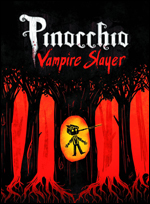Pinocchio: Vampire Slayer
 Pinocchio: Vampire Slayer
Pinocchio: Vampire Slayer
Written by: Van Jensen
Illustrated by: Dusty Higgins
Publisher: Slave Labor Graphics
Format: Softcover, 6 x 9, 528 pages, Black and White, $24.95
ISBN: 978-1-60309-347-7
The American Library Association (ALA) recently named Pinocchio, Vampire Slayer to its list of Great Graphic Novels for Teens, and I couldn't agree more. Reincarnating the wooden puppet to be a vampire-slaying hero, Van Jensen and Higgins breathe new, exciting graphic-novel-life into this once-familiar tale.
In Pinocchio, Vampire Slayer, is determined to revenge the murder of his beloved father, Gepetto. And armed with his wooden nose, which just so happens to come in handy this time, Pinocchio is able to slice through the murderous and evil vampires, ultimately turning them into dust. Before I give away too much of this well-told and visually-aesthetic graphic novel, let's just say that, in the end, readers will find out whether or not Pinocchio will not only revenge his father’s death, but also save himself and the entire town.
An excellent graphic novel for discussing the theme of good and evil, teachers and librarians may just want to ask today's young readers: "Is Pinocchio a real hero?"
If you and your students want to help this modernized Pinocchio fight the good fight against the evil vampires you can go to the Pinocchio: Vampire Slayer website: http://pinocchiovampireslayer.com/.
English Language Arts Elements of Story
Plot: A new version of the Pinocchio story, Pinocchio: Vampire Slayer focuses on a modern, vampire slaying Pinocchio who is dead set on revenging the death of his father, Gepetto.
Setting: The town of Nasolungo
Major Characters: Pinocchio, Gepetto, vampires, cricket, Cherry, the Blue Fairy (Candenella), Carlotta, Carlotta's father, fox and cat, townspeople, rabbits of ill portent
Themes: Identity, Friendship, Family, Revenge, Good & Evil, Heroes & Villains, Action Adventure, Agendas and/or Plans
Literary Pairing Suggestions: Pinocchio (1881) by Carlo Collodi, Pinocchio (1940) by Disney, Animal Farm (1945) by George Orwell, Lord of the Flies (1954) by William Golding, The Lion, the Witch, and the Wardrobe (1950) by C.S. Lewis, Alice in Wonderland (1865) by Lewis Carroll, fairy tales by the Brothers Grimm or Hans Christian Andersen
Some Teaching Recommendations For Middle School & High School English Language Arts
Suggested Alignment to the IRA /NCTE Standard(s):*
- standard #s correspond to the numbers used by IRA/NCTE
5. Students employ a wide range of strategies as they write and use different writing process elements appropriately to communicate with different audiences for a variety of purposes.
11. Students participate as knowledgeable, reflective, creative, and critical members of a variety of literacy communities.
12. Students use spoken, written, and visual language to accomplish their own purposes (e.g., for learning, enjoyment, persuasion, and the exchange of information).
Recommended Grade Levels: 8th – 12th
Suggested Guided Writing Lesson Plans
1. Planning
To plan for this guided writing lesson plan teachers and librarians will need to organize readers into small groups of 3 or 4. Each small group will need pens/pencils, and paper.
2. Mini-Lesson
Building upon Van Jensen and Higgins' Pinocchio, Vampire Slayer and another literary text, teachers and librarians can introduce this mini-lesson by writing each text’s title on the board, ultimately setting up a table. One text at a time, discuss each text’s: plot(s), setting(s), character(s), and theme(s).
For example,
|
Elements of Story |
Pinocchio, Vampire Slayer |
2nd Text |
|
Plot(s) |
|
|
|
Setting(s) |
|
|
|
Character(s)
|
|
|
|
Theme(s)
|
|
|
When the class has identified and discussed each text’s plot(s), setting(s), character(s), and theme(s), the students can then be asked to work in their small groups. In those groups, teachers and librarians can introduce the writing activity.
3. Write
The writing prompt is as follows: "Reflect on the table we completed as a class, and, in your small groups, fill out this new table, which contains two compare and/or contrast questions."
|
Questions |
Answers |
|
Compare: "How are the texts similar?"
|
|
|
Contrast: "How are the texts different?"
|
|
4. Conference
As the students fill out the second table, teachers should move around the room and conference with them.
5. Share
When the small groups are done with the second table teachers can engage students in a whole class discussion. It is recommended that the table either be written on the board or projected for all students to see; this way, all of the small groups can see their ideas be added to the table.
*NCTE/IRA. (1996). Standards for the English Language Arts. Urbana, IL: NCTE.
Katie Monnin, PhD, is an assistant professor of literacy at the University of North Florida and author of Teaching Graphic Novels: Practical Strategies for the Secondary ELA Classroom (2010) from Maupin House. To learn more about Teaching Graphic Novels or Katie Monnin, please go to this link: http://www.maupinhouse.com/monnin.php.


